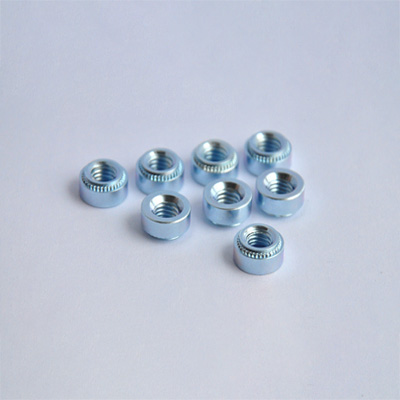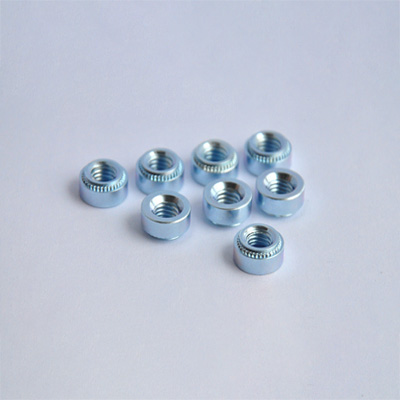
The Self-Clinching Rivet Nut is inserted into a pre-drilled or punched hole and secured by applying pressure, which embeds the nut into the material without needing additional welding or soldering. It creates a flush, clean, and professional finish, providing a solid base for threaded fasteners like screws and bolts. These Rivet Nuts are typically used in sheet metal, aluminum, and other lightweight but sturdy materials.

Self-Clinching Design:
The rivet nut features a knurled or serrated shaft with a flange. When installed, the knurled section bites into the material, ensuring that the nut does not rotate or loosen over time.
The flange provides a stable and secure fit, distributing pressure evenly and preventing material deformation during installation.
Material Composition:
Common materials include stainless steel, carbon steel, aluminum, and brass, providing options for different strength, corrosion resistance, and weight requirements.
Surface treatments like zinc plating, nickel plating, or anodizing are available for enhanced corrosion resistance and aesthetics.
Threaded Internal Design:
Internal threads are precisely formed to provide a reliable connection for bolts or screws.
Thread sizes are available in both metric (M3, M4, M5, etc.) and imperial standards (UNC, UNF).
1.Strong and Durable: Provides high-strength load-bearing capability, especially in thin materials where standard nuts would not be feasible.
2.Vibration Resistance: Designed to resist loosening due to vibrations, making it ideal for applications in dynamic environments.
3.Easy Installation: Requires minimal tools for installation, typically only needing a standard press or rivet tool.
4.Flush Finish: Provides a clean, professional, and low-profile appearance, as the nut sits flush with the material surface.
5.Versatility: Suitable for a wide range of materials, including sheet metal, plastics, and composites.
| Technical Parameter | Specification |
|---|---|
| Material | Stainless Steel, Carbon Steel, Aluminum, Brass |
| Finish | Zinc Plated, Nickel Plated, Anodized, Plain |
| Thread Type | Metric (M3 - M12), Imperial (UNC, UNF) |
| Head Style | Flat, Countersunk, Low Profile |
| Shank Style | Smooth, Knurled, Hexagonal |
| Installation Method | Press-fit, Hand Tool, Pneumatic Installation |
| Grip Range | 0.5mm - 6.0mm (varies based on size) |
| Thread Pitch | As per ISO standards for metric; UNC/UNF for imperial |
| Minimum Sheet Thickness | 0.5mm - 3.0mm (depending on nut size) |
| Tensile Strength | 1000 - 6000 N (varies based on material and size) |
| Torque Resistance | High resistance due to self-clinching design |
| Corrosion Resistance | Varies based on material and finish; stainless steel offers the highest resistance |
Automotive Industry:
Widely used in automotive manufacturing for securing panels, dashboards, and electronic enclosures.
Ideal for applications where vibration resistance is crucial, such as in engines and chassis.
Electronics and Enclosures:
Used to secure PCBs, circuit boards, and other electronic components in enclosures.
Provides a solid base for mounting components without damaging delicate surfaces.
Aerospace:
Suitable for lightweight structures where strength and reliability are required.
Used in aircraft panels, instrumentation, and control systems for secure attachment.
Construction and Furniture:
Provides secure attachment points for modular furniture, building panels, and metal frames.
Ensures a professional and clean appearance with a flush installation.
Sheet Metal Fabrication:
Ideal for metal fabricators needing reliable fastening in thin sheet metal components.
Used in HVAC systems, metal casings, and industrial machinery.
1.Hole Preparation: A pre-drilled or punched hole is created in the sheet metal or substrate according to the recommended hole size for the specific rivet nut.
2.Placement: The rivet nut is inserted into the hole, ensuring that the flange rests flush against the material's surface.
3.Press Fit: Using a press tool, rivet gun, or hand tool, pressure is applied, causing the knurled section to grip tightly to the material, securing the nut in place.
4.Verification: Inspect the installation to ensure a flush finish and test the thread for alignment and load capacity.
FAQ
A Self-Clinching Rivet Nut is a type of fastener designed to create a permanent, threaded connection in thin sheet metal or other lightweight materials. It is installed by pressing the nut into a pre-drilled hole, where it becomes securely embedded due to its knurled or serrated body.
A Self-Clinching Rivet Nut is installed by applying pressure to the nut, forcing it into a pre-drilled hole in the material. The pressure causes the serrated or knurled surface to dig into the base material, preventing it from turning or loosening. This creates a solid, reliable threaded anchor point.
Key benefits include easy installation, high-strength fastening, resistance to vibration, a clean and flush appearance, and the ability to provide a durable thread in thin materials that might otherwise be unsuitable for standard nuts and bolts.
They are widely used in the automotive, aerospace, electronics, telecommunications, construction, and furniture industries. These fasteners are ideal for applications requiring secure attachments in thin materials, such as metal panels, electronic enclosures, and lightweight structures.
Common materials include stainless steel, carbon steel, aluminum, and brass. The choice of material depends on the required strength, corrosion resistance, and application environment. Stainless steel is popular for its corrosion resistance, while aluminum is chosen for its lightweight properties.
Choosing the correct size depends on factors like the thickness of the material, the desired thread size, and the load requirements. Manufacturers typically provide size charts that recommend the appropriate rivet nut size based on the material's thickness and hole diameter.
Common head styles include flat, countersunk, and low-profile heads. Flat heads sit flush against the material's surface, countersunk heads allow for a recessed installation, and low-profile heads provide minimal protrusion for a cleaner look.
Installation involves drilling or punching a hole to the correct size, placing the rivet nut into the hole, and applying pressure using a press tool, pneumatic gun, or hand tool. The pressure embeds the nut securely, creating a permanent and stable threaded connection.
Yes, they can be used with plastics and composite materials, but it's important to choose the appropriate type and material of the rivet nut. Some rivet nuts are specifically designed for use with softer materials to prevent cracking or deformation during installation.
A Self-Clinching Rivet Nut provides a threaded anchor point in thin materials, allowing screws or bolts to be inserted and removed as needed, offering reusability. A traditional rivet, on the other hand, is a one-time-use fastener that joins two materials permanently without the ability to insert a threaded fastener.